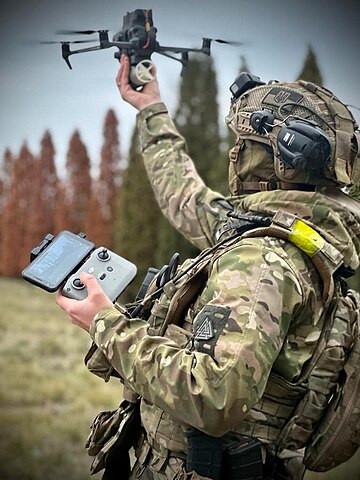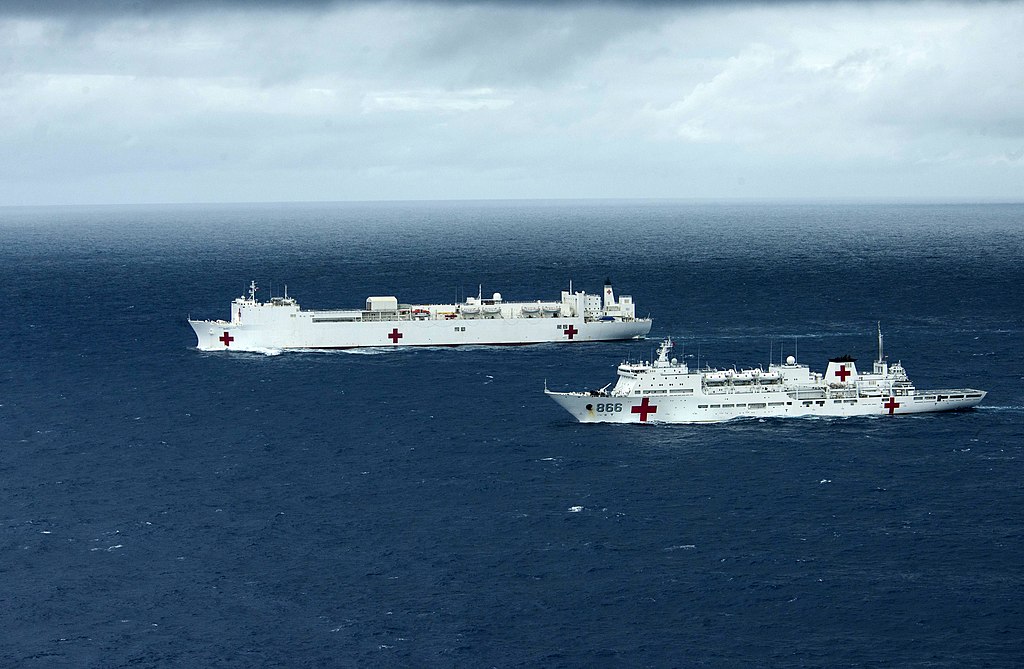
Soldier from Ukrainian 25th Air Assault Brigade employing Small bomb carrying UAV.
“Low altitude is the “junction” connecting airspace and land. With the rapid development and large-scale application of low-altitude combat equipment such as helicopters, small and medium-sized unmanned aerial vehicles, and cruise missiles, the low-altitude battlefield has become increasingly important, and low-altitude control has become one of the comprehensive dominances that must be seized in future land warfare.”
A recent PLA Daily article discusses the importance of low-altitude air control for ground operations and its difference from traditional concepts of air dominance.[i] The article appears to be influenced by recent conflicts such as the Russian invasion of Ukraine and the war between Armenia and Azerbaijan.
Seizing low-altitude air control requires an integrated air defense and distributed, networked, system of systems integrating ground and low-altitude air systems with modular, mobile, multi-domain capabilities. The importance of seizing low-altitude air control[ii] is based on the large-scale use of small and medium unmanned aerial vehicles (UAVs), helicopters, and cruise missiles. Traditional air dominance[iii] cannot guarantee low-altitude air control due to the sundry of small arms and short-range systems that threaten low flying airframes. The author argues that traditional air dominance operations are generally more centralized, while low-altitude air control is an ongoing, independent, and decentralized tactical operation that seizes control in a certain location for a limited time. Decentralized low-altitude air defense operations to seize control require accurate intelligence with the capability to distinguish between friend and foe, coordinated communications, and timely warning of air threats.
Achieving the capability to control the low-altitude air space even for short periods will threaten an adversary’s ability to employ UAVs and fixed and rotary winged aviation. The author urges the PLA to accelerate the development of intelligent air control UAVs with swarming capabilities, loitering munitions, detection systems to identify low, slow, micro-targets, and innovative tactics to seize low-altitude air control in the critical place and time to influence ground combat. . The capability to control the low-altitude air space would give the PLA a significant advantage protecting its forces and critical infrastructure.
Source:
夺取未来陆战低空制权 (Seize the low-altitude dominance of future land warfare),” PLA Daily (official PRC military newspaper), 23 May 2023. http://www.81.cn/szb_223187/szbxq/index.html?paperName=jfjb&paperDate=2023-05-23&paperNumber=07&articleid=906414
“Low-altitude control is a relatively independent and decentralized tactical-level space control. Low altitude control cannot be achieved and controlled through a single operation or a stage of centralized air control operations. Seizing low altitude control power will run through the entire process of combat, displaying a “distributed, discrete” form with strong tactical, regional, mobile, and full process characteristics. Even without the guarantee of traditional air supremacy, through active actions, it is possible to seize low-altitude supremacy in a certain area and within a certain time limit, forming a low-altitude combat advantage.
To seize low altitude dominance, we should focus on the characteristics of the struggle for low altitude control, establish the concept of “relying on ground control, dynamic control, precise control, and flexible use of air”, and follow the basic principle of “whoever uses it seizes it, seizes it as needed, and manages it as needed”. By seizing it in combat, maneuvering, and using it, we can respectively seize low-altitude control power in the task area through relatively independent and dispersed low-altitude combat and low-altitude air defense operations. At the same time, it is necessary to dynamically implement low altitude airspace monitoring and management, establish a low altitude multi-means and multi-mode monitoring system, fully grasp low altitude situations, strengthen collaborative communication, accurately distinguish between enemy and friendly platforms, timely warning, quickly strike and destroy enemy air combat equipment and air control equipment, accurately handle our air conflicts, and ensure effective control of low altitude and ultra-low altitude airspace.
The low-altitude power struggle in future intelligent warfare will become more intense. The Army’s field air defense system should continuously improve the comprehensive combat effectiveness of the low-altitude airspace, attach great importance to the construction of a distributed low-altitude operational system of systems based on the network, and rely on the network to build air-ground integration, the combination of detection, attack and defense, and mobility, modular low-altitude operational system of systems. Focus on strengthening the research and development of low-altitude detection and monitoring platforms to achieve rapid network deployment and low-altitude ultra-low-altitude high-sensitivity dynamic monitoring, and improve the ability to detect “low, slow and small” aircraft; accelerate the development of intelligent air-controlling UAVs, loitering missiles, and “swarms” to enrich the air-to-ground and multi-mode guidance, multi-mechanism killing, and multi-domain attack capabilities; Continue to improve the ability to detect and attack low-altitude small and micro targets, accelerate the development of new mechanism combat equipment, and form a low-altitude combat capability that covers multiple levels of campaigns, tactics, and operational units.
Notes:
[i] For additional information and perspective, see: Thomas Shrimpton, “Chinese Perspective on Manned-Unmanned Coordinated Operations on the Modern Battlefield,” OE Watch, 06-2023. https://fmso.tradoc.army.mil/2023/chinese-perspective-on-manned-unmanned-coordinated-operations-on-the-modern-battlefield/
[ii] The ability to neutralize enemy air defenses and other weapons systems that could attack low flying aircraft, helicopters, UAVs, and cruise missiles would appear difficult to achieve since these weapons would include small arms and short-range gun and missiles systems.
[iii] The PLA defines air dominance or “command of the air” as the Air Force and other services controlling the battlespace for a period of time. Presumably this encompasses offensive and defensive operations, including electronic and information warfare, to neutralize the enemy’s air defense capabilities. The reference to “a period of time” likely indicates the difficulty of sustaining command of the air.
Image Information:
Image: Soldier from Ukrainian 25th Air Assault Brigade employing Small bomb carrying UAV.
Source: https://commons.wikimedia.org/wiki/File:UA_25th_DShV_Bde_Mavic_3_bomber_01.jpg
Attribution: CC By 4.0

